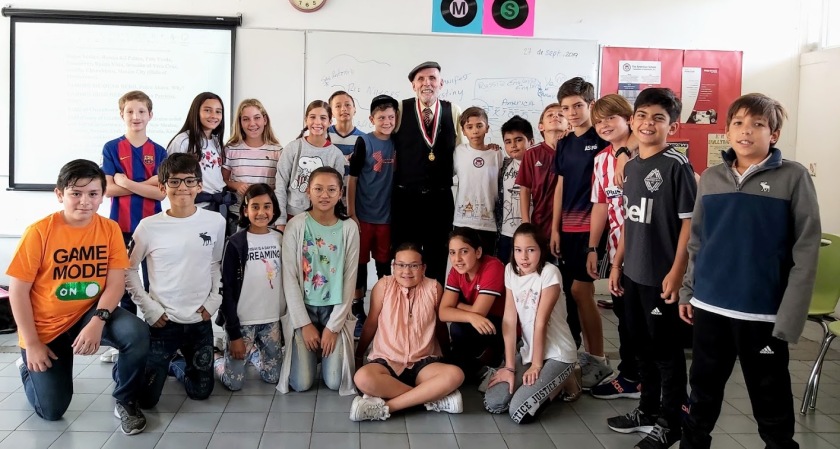
Educator/ historian Michael Hogan with middle school students in Guadalajara, Mexico
Many adults remember middle school years as a time of transition—socially, intellectually, emotionally, and physically. It’s also a time when young minds are quite curious and open to learning.
To stimulate classroom discussion about Abraham Lincoln around his birthday February 12, the Lincoln and Mexico Project (LAMP) is offering middle school educators a complimentary package of supplemental materials.
The materials include an eBook version of Abraham Lincoln and Mexico by educator / historian Michael Hogan that’s in the Lincoln Presidential Library and in more than 400 schools and colleges. The package also includes a three-act play based on the book, along with lesson plans.
Reaching out to middle school educators is part of the overall LAMP outreach to help students learn more about Lincoln, especially his legacy of support for Mexico. During December, Dr. Hogan was invited to speak to four middle school classes at the American School in Guadalajara, where he is Emeritus Humanities Chair, and found students were eager to learn more about Lincoln.
“When I was invited to teach a middle school class on Lincoln and Mexico, I was at first reluctant,” says Dr. Hogan. “Wouldn’t the material be over their heads? Even the high school principal gave me a wink when I told her of the invitation, and said, ‘Good luck with that! You have your work cut out for you.’ What I discovered, however, was that the kids were curious, receptive, and asked probing questions. It was as lively a class as I’ve taught—less self-conscious than many older students, and less cynical.”
Janet Layton Arribas, a middle school teacher in California, knows firsthand about teaching social studies to middle schoolers. She uses LAMP materials in her classroom, and she’s a member of the LAMP Advisory Council helping guide outreach to other educators.
“I believe it is essential to teach middle school students about Lincoln’s strong Mexican connection,” she says. “His opposition to the Mexican American War and his support of Juárez serve as a starting point to many important discussions about race, American exceptionalism, and the complicated historical relationship with our neighbor to the south. These topics remain pertinent today and we need to talk about them more to help us understand who we are as a nation and what kind of neighbor we can be to Mexico.”
President Lyndon Johnson, a former 5th grade teacher, citied his classroom experiences while signing the Elementary and Secondary Education Act on April 11, 1965.
“As a former teacher–and, I hope, a future one–I have great expectations of what this law will mean for all of our young people,” he said. “As President of the United States, I believe deeply no law I have signed or will ever sign means more to the future of America.” You can see the story on the blog of the National Archives.
Many other educators share the belief that these adolescent years are critical to success in high school and beyond. Phyllis Fagell, a certified professional school counselor, has worked in both public and private schools with students in grades K-12, focusing on middle school for the last several years.
“As educators, we need to preserve their natural inquisitiveness and willingness to take risks at an age when they’re feeling particularly scrutinized and judged and may be especially hesitant to go out on a limb,” she is quoted in a recent article on TeachHub.com about the importance of middle school.
Already this year, Dr. Hogan has received invitations from middle school educators in other schools. He can’t accept all the invitations, but materials from LAMP can help middle school educators take advantage of students’ curiosity and openness to learning. To request the free materials, just send an email to lamp@lincolnandmexicoproject.org.
